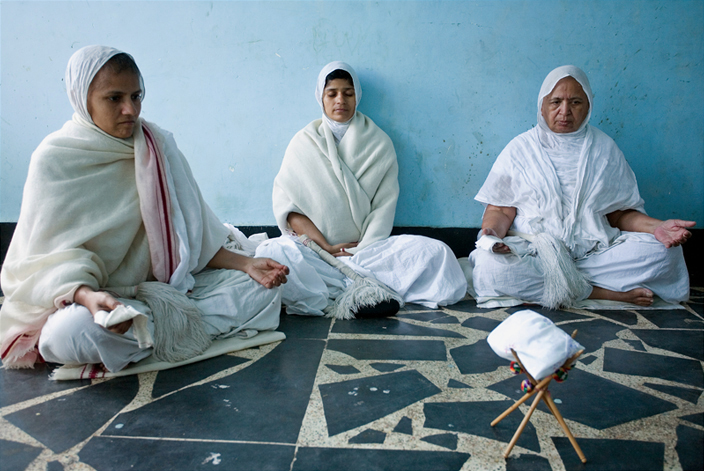|
Svetasvatara Upanishad
The ''Shvetashvatara Upanishad'' ( sa, श्वेताश्वतरोपनिषद् or or , IAST: ' or ') is an ancient Sanskrit text embedded in the Yajurveda. It is listed as number 14 in the Muktika canon of 108 Upanishads. The Upanishad contains 113 mantras or verses in six chapters.Robert Hume (1921)Shvetashvatara Upanishad The Thirteen Principal Upanishads, Oxford University Press, pages 394–411 with footnotes The Upanishad is one of the 33 Upanishads from Taittiriyas, and associated with the ''Shvetashvatara'' tradition within ''Karakas sakha'' of the Yajurveda. It is a part of the "black" "krishna" Yajurveda, with the term "black" implying "the un-arranged, motley collection" of content in Yajurveda, in contrast to the "white" (well arranged) Yajurveda where Brihadaranyaka Upanishad and Isha Upanishad are embedded. The chronology of Shvetashvatara Upanishad is contested, but generally accepted to be a late period Upanishadic composition.Stephen Phillips (200 ... [...More Info...] [...Related Items...] OR: [Wikipedia] [Google] [Baidu] |
Samhita
Saṃhitā literally means "put together, joined, union", a "collection", and "a methodically, rule-based combination of text or verses". Monier-Williams' Sanskrit-English Dictionary, Oxford University Press, page 1123 ''Saṃhitā'' also refers to the most ancient layer of text in the s, consisting of s, hymns, prayers, and s.Lochtefeld, James G. "Samhita" in The I ... [...More Info...] [...Related Items...] OR: [Wikipedia] [Google] [Baidu] |
Meditate Tapasya Dhyana
Meditation is a practice in which an individual uses a technique – such as mindfulness, or focusing the mind on a particular object, thought, or activity – to train attention and awareness, and achieve a mentally clear and emotionally calm and stable state. Meditation is practiced in numerous religious traditions. The earliest records of meditation (''dhyana'') are found in the Upanishads, and meditation plays a salient role in the contemplative repertoire of Jainism, Buddhism and Hinduism. Since the 19th century, Asian meditative techniques have spread to other cultures where they have also found application in non-spiritual contexts, such as business and health. Meditation may significantly reduce stress, anxiety, depression, and pain, and enhance peace, perception, self-concept, and well-being. Research is ongoing to better understand the effects of meditation on health (psychological, neurological, and cardiovascular) and other areas. Etymology The English ''meditatio ... [...More Info...] [...Related Items...] OR: [Wikipedia] [Google] [Baidu] |
Tapas (Sanskrit)
Tapas (Sanskrit: तपस्) is a variety of austere spiritual meditation practices in Indian religions. In Jainism, it means asceticism (austerities, body mortification); in Buddhism, it denotes spiritual practices including meditation and self-discipline; and in the different traditions within Hinduism it means a spectrum of practices ranging from asceticism, inner cleansing to self-discipline by meditation practices. The ''Tapas'' practice often involves solitude, and is a part of monastic practices that are believed to be a means to moksha (liberation, salvation). In the Vedas literature of Hinduism, fusion words based on ''tapas'' are widely used to expound several spiritual concepts that develop through heat or inner energy, such as meditation, any process to reach special observations and insights, the spiritual ecstasy of a yogin or ''Tāpasa'' (a vṛddhi derivative meaning "a practitioner of austerities, an ascetic"), even warmth of sexual intimacy.Kaelber, W. O. (197 ... [...More Info...] [...Related Items...] OR: [Wikipedia] [Google] [Baidu] |
Satya
''Satya'' (Sanskrit: सत्य; IAST: ''satya)'' is a Sanskrit word loosely translated as truth, essence. A. A. Macdonell, ''Sanskrit English Dictionary'', Asian Educational Services, , pp. 330–331 It also refers to a virtue in Indian religions, referring to being truthful in one's thought, speech and action. In Yoga, ''satya'' is one of five yamas, the virtuous restraint from falsehood and distortion of reality in one's expressions and actions.GR Garg, ''Encyclopaedia of the Hindu World'', Volume 3, , p. 733 Etymology and meaning In the Vedas and later sutras, the meaning of the word satya () evolves into an ethical concept about truthfulness and is considered an important virtue.KN Tiwari (1998), ''Classical Indian Ethical Thought'', Motilal Banarsidass, , p. 87 It means being true and consistent with reality in one's thought, speech, and action. Satya is said to have cognates in a number of diverse Indo-European languages, including the word "sooth" and "sin" in Englis ... [...More Info...] [...Related Items...] OR: [Wikipedia] [Google] [Baidu] |
Moksha
''Moksha'' (; sa, मोक्ष, '), also called ''vimoksha'', ''vimukti'' and ''mukti'', is a term in Hinduism, Buddhism, Jainism and Sikhism for various forms of emancipation, enlightenment, liberation, and release. In its soteriology, soteriological and eschatology, eschatological senses, it refers to freedom from ''saṃsāra'', the cycle of death and Reincarnation, rebirth. In its epistemology, epistemological and psychological senses, ''moksha'' is freedom from ignorance: self-realization, self-actualization and self-knowledge. In Hindu traditions, ''moksha'' is a central concept and the utmost aim of human life; the other three aims being ''dharma'' (virtuous, proper, moral life), ''artha'' (material prosperity, income security, means of life), and ''kama'' (pleasure, sensuality, emotional fulfillment). Together, these four concepts are called Puruṣārtha in Hinduism. In some schools of Indian religions, ''moksha'' is considered equivalent to and used interchange ... [...More Info...] [...Related Items...] OR: [Wikipedia] [Google] [Baidu] |
Adi Shankara
Adi Shankara ("first Shankara," to distinguish him from other Shankaras)(8th cent. CE), also called Adi Shankaracharya ( sa, आदि शङ्कर, आदि शङ्कराचार्य, Ādi Śaṅkarācāryaḥ, lit=First Shankaracharya, ), was an Indian Vedic scholar and teacher (''acharya''), whose works present a harmonizing reading of the ''sastras'', with liberating knowledge of the self at its core, synthesizing the Advaita Vedanta teachings of his time. The title of Shankracharya, used by heads of the amnaya monasteries is derived from his name. Due to his later fame, over 300 texts are attributed to his name, including commentaries (''Bhāṣya''), introductory topical expositions (''Prakaraṇa grantha'') and poetry (''Stotra''). However most of these are likely to be by admirers or pretenders or scholars with an eponymous name.W Halbfass (1983), Studies in Kumarila and Sankara, Studien zur Indologie und Iranistik, Monographic 9, Reinbeck Works known ... [...More Info...] [...Related Items...] OR: [Wikipedia] [Google] [Baidu] |
Guṇa
( sa, गुण) is a concept in Hinduism, Jainism and Sikhism, which can be translated as "quality, peculiarity, attribute, property".guna Monier Williams' Sanskrit-English Dictionary, Cologne Digital Sanskrit Lexicon, GermanyguNa Sanskrit-English Dictionary, Koeln University, Germany The concept is originally notable as a feature of philosophy. The gunas are now a key concept in nearly all schools of |
Max Muller
Max or MAX may refer to: Animals * Max (dog) (1983–2013), at one time purported to be the world's oldest living dog * Max (English Springer Spaniel), the first pet dog to win the PDSA Order of Merit (animal equivalent of OBE) * Max (gorilla) (1971–2004), a western lowland gorilla at the Johannesburg Zoo who was shot by a criminal in 1997 Brands and enterprises * Australian Max Beer * Max Hamburgers, a fast-food corporation * MAX Index, a Hungarian domestic government bond index * Max Fashion, an Indian clothing brand Computing * MAX (operating system), a Spanish-language Linux version * Max (software), a music programming language * Commodore MAX Machine * Multimedia Acceleration eXtensions, extensions for HP PA-RISC Films * ''Max'' (1994 film), a Canadian film by Charles Wilkinson * ''Max'' (2002 film), a film about Adolf Hitler * ''Max'' (2015 film), an American war drama film Games * '' Dancing Stage Max'', a 2005 game in the ''Dance Dance Revolution'' series * ''DDRM ... [...More Info...] [...Related Items...] OR: [Wikipedia] [Google] [Baidu] |
Purusha
''Purusha'' (' or ) is a complex concept whose meaning evolved in Vedic and Upanishadic times. Depending on source and historical timeline, it means the cosmic being or self, awareness, and universal principle.Karl Potter, Presuppositions of India’s Philosophies, Motilal Banarsidass, , pp 105-109 In early Vedas, ''Purusha'' was a cosmic being whose sacrifice by the gods created all life. This was one of many creation myths discussed in the Vedas. In the Upanishads, the ''Purusha'' concept refers to the abstract essence of the Self, Spirit and the Universal Principle that is eternal, indestructible, without form, and is all-pervasive. In Sankhya philosophy, Purusha is the plural immobile cosmic principle, pure consciousness, unattached and unrelated to anything, which is “nonactive, unchanging, eternal, and pure”. Purusha uniting with Prakṛti (matter) gives rise to life. In Kashmir Shaivism, Purusha is enveloped in five sheaths of time (''Kāla''), desire (''Raga''), ... [...More Info...] [...Related Items...] OR: [Wikipedia] [Google] [Baidu] |
Unmoved Mover
The unmoved mover ( grc, ὃ οὐ κινούμενον κινεῖ, ho ou kinoúmenon kineî, that which moves without being moved) or prime mover ( la, primum movens) is a concept advanced by Aristotle as a primary cause (or first uncaused cause) or " mover" of all the motion in the universe. As is implicit in the name, the moves other things, but is not itself moved by any prior action. In Book 12 ( grc-gre, Λ) of his ''Metaphysics'', Aristotle describes the unmoved mover as being perfectly beautiful, indivisible, and contemplating only the perfect contemplation: self-contemplation. He equates this concept also with the active intellect. This Aristotelian concept had its roots in cosmological speculations of the earliest Greek pre-Socratic philosophers and became highly influential and widely drawn upon in medieval philosophy and theology. St. Thomas Aquinas, for example, elaborated on the unmoved mover in the . First philosophy Aristotle argues, in Book 8 of the ''Physics ... [...More Info...] [...Related Items...] OR: [Wikipedia] [Google] [Baidu] |
Ashrama (stage)
Ashrama may refer to: * Ashram (''āśrama''), a spiritual hermitage or a monastery in Indian religions *Ashrama (stage) (''āśrama''), in Hinduism is one of four age-based life stages discussed in ancient and medieval era Indian texts. *Ashrama, California Shanti Ashrama is a spiritual retreat located in the Upper San Antonio Valley in unincorporated Santa Clara County, California, United States as a branch of the Ramakrishna Mission. It is approximately east of downtown San Jose. History ..., an unincorporated community in Santa Clara County See also * Ashram (other) {{disambiguation ... [...More Info...] [...Related Items...] OR: [Wikipedia] [Google] [Baidu] |



